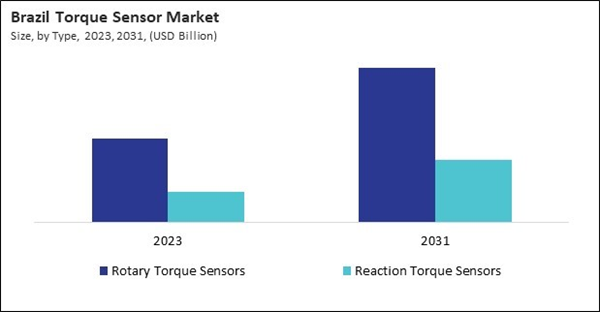Strain gauge technology is a fundamental aspect of torque sensors, including both rotary and reaction types. These sensors utilize strain gauges, which are small devices that change resistance when subjected to mechanical strain or deformation. In torque sensors, strain gauges are strategically placed on a torsionally flexible element, such as a shaft or a torsion bar, which deforms slightly when torque is applied. This deformation causes the strain gauges to stretch or compress, altering their electrical resistance in proportion to the torque applied. Therefore, the Brazil market utilized 110.07 strain gauged sensors in 2023.
The Brazil market dominated the LAMEA Torque Sensor Market by Country in 2023, and would continue to be a dominant market till 2031; thereby, achieving a market value of $435.1 million by 2031. The Argentina market is showcasing a CAGR of 10.4% during (2024 - 2031). Additionally, The UAE market would register a CAGR of 9.2% during (2024 - 2031).
Advancements in sensor fusion techniques, such as integrating torque sensors with other sensors like accelerometers, gyroscopes, and position sensors, enable multi-axis force and torque measurement with higher accuracy and precision. This integrated approach enhances the versatility and functionality of torque sensing systems, allowing for comprehensive motion analysis and control in complex applications.
Furthermore, developments in materials science have led to the emergence of flexible and conformable torque sensors that can be integrated into curved or irregular surfaces, opening up new possibilities for torque measurement in unconventional environments. Additionally, using advanced signal processing algorithms, machine learning, and artificial intelligence (AI) techniques enables predictive modeling, anomaly detection, and optimization of torque sensing systems for enhanced performance and reliability.
With the adoption of Industry 4.0 principles, UAE manufacturers are increasingly integrating automation and smart technologies into their production processes. Torque sensors are integral to automated manufacturing systems, enabling real-time monitoring and control of torque levels for enhanced productivity and quality assurance. As per the Government of the U.A.E, the value added to GDP in 2020 for the manufacturing industry was USD 34.75 billion. Furthermore, with the rise of automotive manufacturing plants in Saudi Arabia, torque sensors will be crucial for ensuring the quality and reliability of vehicles being produced. As per the data provided in 2021 by the International Trade Administration, the automotive sector in Middle East and North Africa (MENA) region was experiencing a 36% growth rate, with Saudi Arabia emerging as the primary industry in the area. In 2020, Saudi Arabia constituted 35% of the vehicles sold in the MENA region and nearly 52% of the vehicles sold in the Gulf Cooperation Council (GCC). In 2019, 556 thousand vehicles were sold in Saudi Arabia; in 2020, 436 thousand vehicles were sold. The projected sales figure by 2025 is 543,000 units. Hence, the growing automotive and manufacturing sectors in LAMEA will pose lucrative growth prospects for the regional torque sensor market.
Based on Type, the market is segmented into Rotary Torque Sensors, and Reaction Torque Sensors. Based on Application, the market is segmented into Automotive, Aerospace & Defense, Test & Measurement, Industrial, and Others. Based on Technology, the market is segmented into Strain Gauge, Magnetoelastic, Surface Acoustic Wave, and Others. Based on countries, the market is segmented into Brazil, Argentina, UAE, Saudi Arabia, South Africa, Nigeria, and Rest of LAMEA.
List of Key Companies Profiled
- Honeywell International, Inc.
- ABB Ltd.
- Amphenol Corporation (PCB Piezotronics, Inc.)
- Sensor Technology Ltd.
- FUTEK Advanced Sensor Technology, Inc.
- TE Connectivity Ltd.
- ATI Industrial Automation, Inc. (Novanta, Inc.)
- Spectris PLC (HBM)
- Interface, Inc.
- Datum Electronics Ltd. (Indutrade AB)
Market Report Segmentation
By Type (Volume, Thousand Units, USD Billion, 2020-31)- Rotary Torque Sensors
- Reaction Torque Sensors
- Automotive
- Aerospace & Defense
- Test & Measurement
- Industrial
- Others
- Strain Gauge
- Magnetoelastic
- Surface Acoustic Wave
- Others
- Brazil
- Argentina
- UAE
- Saudi Arabia
- South Africa
- Nigeria
- Rest of LAMEA
Table of Contents
Companies Mentioned
- Honeywell International, Inc.
- ABB Ltd.
- Amphenol Corporation (PCB Piezotronics, Inc.)
- Sensor Technology Ltd.
- FUTEK Advanced Sensor Technology, Inc.
- TE Connectivity Ltd.
- ATI Industrial Automation, Inc. (Novanta, Inc.)
- Spectris PLC (HBM)
- Interface, Inc.
- Datum Electronics Ltd. (Indutrade AB)
Methodology

LOADING...









